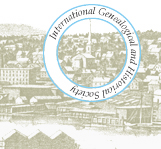

 |
 |
The Genealogical - Historical Databases PROLOGUE Today computer technology and large digital storage systems coupled with remote communication infrastructure has made it possible to harness great amounts of genealogical information and coordinated human resources to initiate the start of the genealogical - historical databases project. The science and art of genealogy has the ability to take a quantum leap in the assemblage and dissemination of information. There are vast amounts of genealogical and historical information entombed in many libraries as well as personal records around the world which see relatively little access because of a the static geographical locations of these depositories. It is now possible to create a platform for the consolidation of many far flung libraries/records of research and scholarship into large scale wide area genealogical and historical databases. Although it might seem a massive undertaking, the employment of an interactive system that an unlimited number of researchers could view and input great amounts of information would grow very quickly. The database would not be a project with an end point or deadline but one that would always be growing, evolving and correcting. It would be a platform for scholarship and discussion. It would NOT be an open submission type database. The database would not be a substitute or replace written works or journals but an addition to them, in fact a coherent consolidation of them along with separate vital records and other germane information. This database should be open to a wide expansion of international lineages. This database because of its ability to be accessed through the internet would be shared by membership and participating associations worldwide. It would generate expanded membership in the society and probably expand a greater interest in genealogy and history itself. CONTRIBUTORS It is proposed that the data would be assembled by an unlimited number of contributors at once, genealogists, biographers and historians, both professional and serious amateur, and historians, all who would be certified to participate. It is proposed that although all members of participating societies have access to the data, that contributors would be allowed only by credentials or invitation. All data entered would also be certified in some way by each of those persons as to the information source of the data so that there would be a responsibility for the integrity of information. Written sources themselves would be certified and accepted for their veracity. The interaction of participants would not only develop interlinked information but tend to promote correct data and weed out erroneous historical data. Once started, participation could be shared by other societies on a participating basis and their supporting membership. This would also encourage membership. ACCESS The database would be Non - Profit. The Database would ultimately be accessed by contributors and by subscribers both individual and institutional for the purposes of creating an annuity to PERPETUATE the database, for staffing and for projects which would benefit the Database and promote Genealogical and Historical understanding. DATABASE The database is presently The Database is presently being built at Carnegie Mellon University by Phil Croul, Spencer Ying, Kelly Chan and Daniel Peterson with Professor Randy S. Weinberg. STAFFING Several genealogists and historians have voiced their concerns about maintaining the VERACITY of such a huge amount of data and the huge staffing that would require. The proposed format would be that when researchers find errors that they contact the contributor to resolve the issue. This has in the past been a successful method of maintaining the veracity of a body of work. ONLY when there is an unresolved dispute would such a matter be submitted for resolution to a committee expert in the individual matter. It is foreseen that while genealogical journals attain a veracity of about 97% this method of open dynamic correction would attain better than 99%. IT staff to ensure continuous running of the system and equipment. Managing content should be an initial block of time by a committee to set rules, parameters and standards and then a staff member or Director to manage participant certification and resolving problems, monitoring progress and linking files. There would be regional as well as subject committees to monitor and share expertise in their specific areas. A committee would monitor issues which arise and accept bodies of works. CONCLUSION The Genealogical - Historical Databases would be an excellent achievement for the art and science of genealogy, biography and history. Michael Wolfe, Director
|